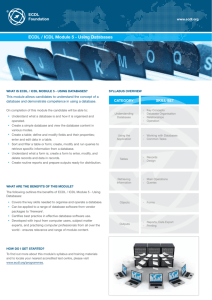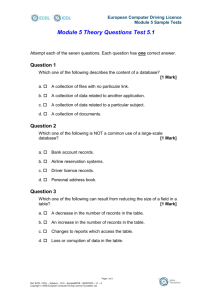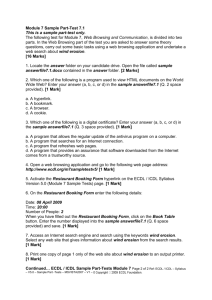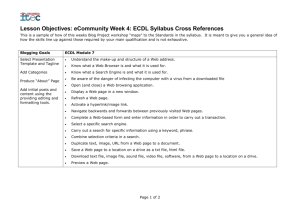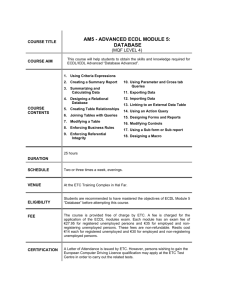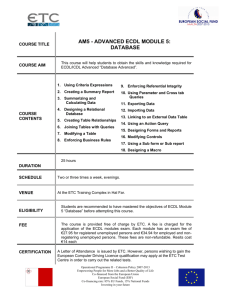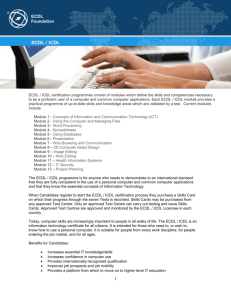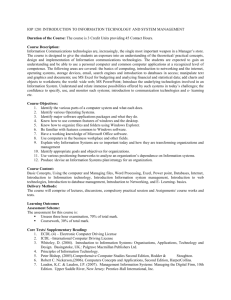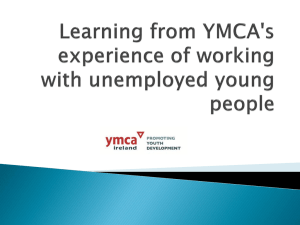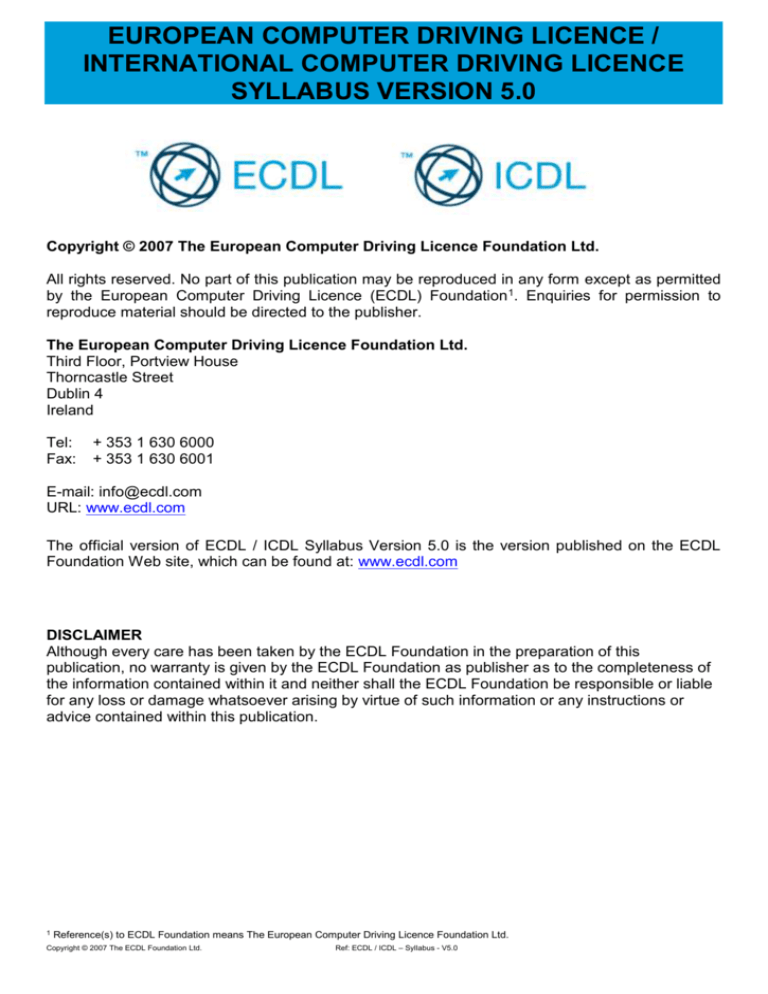
EUROPEAN COMPUTER DRIVING LICENCE /
INTERNATIONAL COMPUTER DRIVING LICENCE
SYLLABUS VERSION 5.0
Copyright © 2007 The European Computer Driving Licence Foundation Ltd.
All rights reserved. No part of this publication may be reproduced in any form except as permitted
by the European Computer Driving Licence (ECDL) Foundation 1. Enquiries for permission to
reproduce material should be directed to the publisher.
The European Computer Driving Licence Foundation Ltd.
Third Floor, Portview House
Thorncastle Street
Dublin 4
Ireland
Tel:
Fax:
+ 353 1 630 6000
+ 353 1 630 6001
E-mail: info@ecdl.com
URL: www.ecdl.com
The official version of ECDL / ICDL Syllabus Version 5.0 is the version published on the ECDL
Foundation Web site, which can be found at: www.ecdl.com
DISCLAIMER
Although every care has been taken by the ECDL Foundation in the preparation of this
publication, no warranty is given by the ECDL Foundation as publisher as to the completeness of
the information contained within it and neither shall the ECDL Foundation be responsible or liable
for any loss or damage whatsoever arising by virtue of such information or any instructions or
advice contained within this publication.
1
Reference(s) to ECDL Foundation means The European Computer Driving Licence Foundation Ltd.
Copyright © 2007 The ECDL Foundation Ltd.
Ref: ECDL / ICDL – Syllabus - V5.0
CONTENTS
Module 1 – Concepts of Information and Communication Technology (ICT)
2
Module 2 – Using the Computer and Managing Files
6
Module 3 – Word Processing
9
Module 4 – Spreadsheets
13
Module 5 – Using Databases
17
Module 6 – Presentation
21
Module 7 – Web Browsing and Communication
25
Copyright © 2007 The ECDL Foundation Ltd.
Ref: ECDL / ICDL – Syllabus - V5.0
Page 1 of 29
Module 1 –Concepts of Information and Communication Technology (ICT)
The following is the Syllabus for Module 1, Concepts of Information and Communication Technology
(ICT), which provides the basis for the theory-based test in this module.
Module Goals
Module 1
Concepts of Information and Communication Technology (ICT) requires the
candidate to understand the main concepts of ICT at a general level, and to know about
the different parts of a computer.
The candidate shall be able to:
Understand what hardware is, know about factors that affect computer
performance and know about peripheral devices.
Understand what software is and give examples of common applications software
and operating system software.
Understand how information networks are used within computing, and be aware of
the different options to connect to the Internet.
Understand what Information and Communication Technology (ICT) is and give
examples of its practical applications in everyday life.
Understand health and safety and environmental issues in relation to using
computers.
Recognize important security issues associated with using computers.
Recognize important legal issues in relation to copyright and data protection
associated with using computers.
CATEGORY
1.1 Hardware
KNOWLEDGE AREA
1.1.1 Concepts
1.1.2 Computer
Performance
Copyright © 2007 The ECDL Foundation Ltd.
REF.
Knowledge Item
1.1.1.1
Understand the term hardware.
1.1.1.2
Understand what a personal computer is. Distinguish
between desktop, laptop (notebook), tablet PC in terms
of typical users.
1.1.1.3
Identify common handheld portable digital devices like:
personal digital assistant (PDA), mobile phone,
smartphone, multimedia player and know their main
features.
1.1.1.4
Know the main parts of a computer like: central
processing unit (CPU), types of memory, hard disk,
common input and output devices.
1.1.1.5
Identify common input/output ports like: USB, serial,
parallel, network port, FireWire.
1.1.2.1
Know some of the factors that impact on a computer’s
performance like: CPU speed, RAM size, graphics card
processor and memory, the number of applications
running.
1.1.2.2
Know that the speed (operating frequency) of the CPU is
measured in megahertz (MHz) or gigahertz (GHz).
Ref: ECDL / ICDL – Syllabus - V5.0
Page 2 of 29
CATEGORY
KNOWLEDGE AREA
REF.
Knowledge Item
1.1.3 Memory and Storage
1.1.3.1
Know what computer memory is: RAM (random-access
memory), ROM (read-only memory) and distinguish
between them.
1.1.3.2
Know storage capacity measurements: bit, byte, KB,
MB, GB, TB.
1.1.3.3
Know the main types of storage media like: CD, DVD,
USB flash drive, memory card, internal hard disk,
external hard disk, network drive, online file storage.
1.1.4.1
Identify some of the main input devices like: mouse,
keyboard, trackball, scanner, touchpad, stylus, joystick,
web camera (webcam), digital camera, microphone.
1.1.4.2
Know some of the main output devices like:
screens/monitors, printers, speakers, headphones.
1.1.4.3
Understand some devices are both input and output
devices like: touchscreens.
1.2.1.1
Understand the term software.
1.2.1.2
Understand what an operating system is and name
some common operating systems.
1.2.1.3
Identify and know the uses of some common software
applications: word processing, spreadsheet, database,
presentation, e-mail, web browsing, photo editing,
computer games.
1.2.1.4
Distinguish between operating systems software and
applications software.
1.2.1.5
Know some options available for enhancing accessibility
like: voice recognition software, screen reader, screen
magnifier, on-screen keyboard.
1.3.1.1
Understand the terms local area network (LAN),
wireless local area network (WLAN), wide area network
(WAN).
1.3.1.2
Understand the term client/server.
1.3.1.3
Understand what the Internet is and know some of its
main uses.
1.3.1.4
Understand what an intranet, extranet is.
1.3.2.1
Understand the concepts of downloading from,
uploading to a network.
1.3.2.2
Understand what transfer rate means. Understand how
it is measured: bits per second (bps), kilobits per second
(kbps), megabits per second (mbps).
1.3.2.3
Know about different Internet connection services: dialup, broadband.
1.3.2.4
Know about different options for connecting to the
Internet like: phone line, mobile phone, cable, wireless,
satellite.
1.1.4 Input, Output Devices
1.2 Software
1.3 Networks
1.2.1 Concepts
1.3.1 Network Types
1.3.2 Data Transfer
Copyright © 2007 The ECDL Foundation Ltd.
Ref: ECDL / ICDL – Syllabus - V5.0
Page 3 of 29
CATEGORY
1.4 ICT in
Everyday Life
KNOWLEDGE AREA
1.4.1 Electronic World
1.4.2 Communication
1.4.3 Virtual Communities
1.4.4 Health
Copyright © 2007 The ECDL Foundation Ltd.
REF.
Knowledge Item
1.3.2.5
Understand some of the characteristics of broadband:
always on, typically a flat fee, high speed, higher risk of
intruder attack.
1.4.1.1
Understand the term Information and Communication
Technology (ICT).
1.4.1.2
Know about different Internet services for consumers
like: e-commerce, e-banking, e-government.
1.4.1.3
Understand the term e-learning. Know some of its
features like: flexible learning time, flexible learning
location, multimedia learning experience, cost
effectiveness.
1.4.1.4
Understand the term teleworking. Know some of the
advantages of teleworking like: reduced or no
commuting time, greater ability to focus on one task,
flexible schedules, reduced company space
requirements. Know some disadvantages of teleworking
like: lack of human contact, less emphasis on
teamwork.
1.4.2.1
Understand the term electronic mail (e-mail).
1.4.2.2
Understand the term instant messaging (IM).
1.4.2.3
Understand the term Voice over Internet Protocol
(VoIP).
1.4.2.4
Understand the term Really Simple Syndication (RSS)
feed.
1.4.2.5
Understand the term web log (blog).
1.4.2.6
Understand the term podcast.
1.4.3.1
Understand the concept of an online (virtual)
community. Recognize examples like: social networking
websites, Internet forums, chat rooms, online computer
games.
1.4.3.2
Know ways that users can publish and share content
online: web log (blog), podcast, photos, video and audio
clips.
1.4.3.3
Know the importance of taking precautions when using
online communities: make your profile private, limit the
amount of personal information you post, be aware that
posted information is publicly available, be wary of
strangers.
1.4.4.1
Understand the term ergonomics.
1.4.4.2
Recognize that lighting is a health factor in computer
use. Be aware that use of artificial light, amount of light,
direction of light are all important considerations.
1.4.4.3
Understand that correct positioning of the computer,
desk and seat can help maintain a good posture.
Ref: ECDL / ICDL – Syllabus - V5.0
Page 4 of 29
CATEGORY
KNOWLEDGE AREA
1.4.5 Environment
1.5 Security
1.5.1 Identity/Authentication
1.5.2 Data Security
1.5.3 Viruses
1.6 Law
1.6.1 Copyright
1.6.2 Data Protection
Copyright © 2007 The ECDL Foundation Ltd.
REF.
Knowledge Item
1.4.4.4
Recognize ways to help ensure a user’s wellbeing while
using a computer like: take regular stretches, have
breaks, use eye relaxation techniques.
1.4.5.1
Know about the option of recycling computer
components, printer cartridges and paper.
1.4.5.2
Know about computer energy saving options: applying
settings to automatically turn off the screen/monitor, to
automatically put the computer to sleep, switching off
the computer.
1.5.1.1
Understand that for security reasons a user name (ID)
and password are needed for users to identify
themselves when logging on to a computer.
1.5.1.2
Know about good password policies like: not sharing
passwords, changing them regularly, adequate
password length, adequate letter and number mix.
1.5.2.1
Understand the importance of having an off-site backup
copy of files.
1.5.2.2
Understand what a firewall is.
1.5.2.3
Know ways to prevent data theft like: using a user name
and password, locking computer and hardware using a
security cable.
1.5.3.1
Understand the term computer virus.
1.5.3.2
Be aware how viruses can enter a computer system.
1.5.3.3
Know how to protect against viruses and the importance
of updating anti-virus software regularly.
1.6.1.1
Understand the term copyright.
1.6.1.2
Know how to recognize licensed software: by checking
product ID, product registration, by viewing the software
licence.
1.6.1.3
Understand the term end-user license agreement.
1.6.1.4
Understand the terms shareware, freeware, open
source.
1.6.2.1
Identify the main purposes of data protection legislation
or conventions: to protect the rights of the data subject,
to set out the responsibilities of the data controller.
1.6.2.2
Identify the main data protection rights for a data subject
in your country.
1.6.2.3
Identify the main data protection responsibilities for a
data controller in your country.
Ref: ECDL / ICDL – Syllabus - V5.0
Page 5 of 29
Module 2 – Using the Computer and Managing Files
The following is the Syllabus for Module 2, Using the Computer and Managing Files, which
provides the basis for the theory and practice-based test in this module.
Module Goals
Module 2
Using the Computer and Managing Files requires the candidate to demonstrate
competence in running and managing a personal computer.
The candidate shall be able to:
Use the main features of the operating system including adjusting the main
computer settings and using built-in help features.
Operate effectively around the computer desktop and work effectively in a
graphical user environment.
Know about the main concepts of file management and be able to efficiently
organize files and folders so that they are easy to identify and find.
Use utility software to compress and extract large files and use anti-virus
software to protect against computer viruses.
Demonstrate the ability to use simple text editing and print tools available
within the operating system.
CATEGORY
2.1 Operating
System
SKILL SET
2.1.1 First Steps
2.1.2 Setup
2.1.3 Working with Icons
Copyright © 2007 The ECDL Foundation Ltd.
REF.
Task Item
2.1.1.1
Start the computer and log on securely using a user name and
password.
2.1.1.2
Restart the computer using an appropriate routine.
2.1.1.3
Shut down a non-responding application.
2.1.1.4
Shut down the computer using an appropriate routine.
2.1.1.5
Use available Help functions.
2.1.2.1
View the computer’s basic system information: operating
system name and version number, installed RAM (randomaccess memory).
2.1.2.2
Change the computer’s desktop configuration: date & time,
volume settings, desktop display options (colour settings,
desktop background, screen pixel resolution, screen saver
options).
2.1.2.3
Set, add keyboard language.
2.1.2.4
Install, uninstall a software application.
2.1.2.5
Use keyboard print screen facility to capture a full screen,
active window.
2.1.3.1
Identify common icons like those representing: files, folders,
applications, printers, drives, recycle bin/wastebasket/trash.
Ref: ECDL / ICDL – Syllabus - V5.0
Page 6 of 29
CATEGORY
SKILL SET
2.1.4 Using Windows
2.2 File
Management
2.2.1 Main Concepts
2.2.2 Files and Folders
2.2.3 Working with Files
2.2.4 Copy, Move
Copyright © 2007 The ECDL Foundation Ltd.
REF.
Task Item
2.1.3.2
Select and move icons.
2.1.3.3
Create, remove a desktop shortcut icon, make an alias.
2.1.3.4
Use an icon to open a file, folder, application.
2.1.4.1
Identify the different parts of a window: title bar, menu bar,
toolbar or ribbon, status bar, scroll bar.
2.1.4.2
Collapse, expand, restore, resize, move, close a window.
2.1.4.3
Switch between open windows.
2.2.1.1
Understand how an operating system organizes drives,
folders, files in a hierarchical structure.
2.2.1.2
Know devices used by an operating system to store files and
folders like: hard disk, USB flash drive, CD-RW, DVD-RW,
network drives.
2.2.1.3
Know how files, folders are measured: KB, MB, GB.
2.2.1.4
Understand the purpose of regularly backing up data to a
removable storage device for off-site storage.
2.2.1.5
Understand the benefits of online file storage: convenient
access, ability to share files.
2.2.2.1
Open a window to display folder name, size, location on a
drive.
2.2.2.2
Expand, collapse views of drives, folders.
2.2.2.3
Navigate to a folder, file on a drive.
2.2.2.4
Create a folder and a further sub-folder.
2.2.3.1
Identify common file types: word processing files, spreadsheet
files, database files, presentation files, portable document
format files, image files, audio files, video files, compressed
files, temporary files, executable files.
2.2.3.2
Open a text editing application. Enter text into a file, name and
save the file to a location on a drive.
2.2.3.3
Change file status: read-only/locked, read-write.
2.2.3.4
Sort files in ascending, descending order by name, size, type,
date modified.
2.2.3.5
Recognize good practice in folder, file naming: use meaningful
names for folders and files to help with recall and organization.
2.2.3.6
Rename files, folders.
2.2.4.1
Select a file, folder individually or as a group of adjacent, nonadjacent files, folders.
2.2.4.2
Copy files, folders between folders and between drives.
2.2.4.3
Move files, folders between folders and between drives.
Ref: ECDL / ICDL – Syllabus - V5.0
Page 7 of 29
CATEGORY
SKILL SET
2.2.5 Delete, Restore
2.2.6 Searching
2.3 Utilities
2.3.1 File Compression
2.3.2 Anti-Virus
2.4 Print
Management
2.4.1 Printer Options
2.4.2 Print
Copyright © 2007 The ECDL Foundation Ltd.
REF.
Task Item
2.2.5.1
Delete files, folders to the recycle bin/wastebasket/trash.
2.2.5.2
Restore files, folders from the recycle bin/wastebasket/trash.
2.2.5.3
Empty the recycle bin/wastebasket/trash.
2.2.6.1
Use the Find tool to locate a file, folder.
2.2.6.2
Search for files by all or part of file name, by content.
2.2.6.3
Search for files by date modified, by date created, by size.
2.2.6.4
Search for files by using wildcards: file type, first letter of file
name.
2.2.6.5
View list of recently used files.
2.3.1.1
Understand what file compression means.
2.3.1.2
Compress files in a folder on a drive.
2.3.1.3
Extract compressed files from a location on a drive.
2.3.2.1
Understand what a virus is and the ways a virus can be
transmitted onto a computer.
2.3.2.2
Use anti-virus software to scan specific drives, folders, files.
2.3.2.3
Understand why anti-virus software needs to be updated
regularly.
2.4.1.1
Change the default printer from an installed printer list.
2.4.1.2
Install a new printer on the computer.
2.4.2.1
Print a document from a text editing application.
2.4.2.2
View a print job’s progress in a queue using a desktop print
manager.
2.4.2.3
Pause, re-start, delete a print job using a desktop print
manager.
Ref: ECDL / ICDL – Syllabus - V5.0
Page 8 of 29
Module 3 – Word Processing
The following is the Syllabus for Module 3, Word Processing, which provides the basis for the
practice-based test in this module.
Module Goals
Module 3
Word Processing requires the candidate to demonstrate the ability to use a word
processing application to create everyday letters and documents.
The candidate shall be able to:
Work with documents and save them in different file formats.
Choose built-in options such as the Help function to enhance productivity.
Create and edit small-sized word processing documents that will be ready
to share and distribute.
Apply different formats to documents to enhance them before distribution
and recognize good practice in choosing the appropriate formatting options.
Insert tables, images and drawn objects into documents.
Prepare documents for mail merge operations.
Adjust document page settings and check and correct spelling before finally
printing documents.
CATEGORY
3.1 Using the
Application
SKILL SET
REF.
3.1.1 Working with
Documents
3.1.1.1
Open, close a word processing application. Open, close
documents.
3.1.1.2
Create a new document based on default template,
other available template like: memo, fax, agenda.
3.1.1.3
Save a document to a location on a drive. Save a
document under another name to a location on a drive.
3.1.1.4
Save a document as another file type like: text file, Rich
Text Format, template, software specific file extension,
version number.
3.1.1.5
Switch between open documents.
3.1.2.1
Set basic options/preferences in the application: user
name, default folder to open, save documents.
3.1.2.2
Use available Help functions.
3.1.2.3
Use magnification/zoom tools.
3.1.2.4
Display, hide built-in toolbars. Restore, minimize the
ribbon.
3.2.1.1
Switch between page view modes.
3.2.1.2
Enter text into a document.
3.2.1.3
Insert symbols or special characters like: ©, ®, ™.
3.1.2 Enhancing
Productivity
3.2 Document
Creation
3.2.1 Enter Text
Copyright © 2007 The ECDL Foundation Ltd.
Task Item
Ref: ECDL / ICDL – Syllabus - V5.0
Page 9 of 29
CATEGORY
SKILL SET
3.2.2 Select, Edit
3.3 Formatting
3.3.1 Text
3.3.2 Paragraphs
Copyright © 2007 The ECDL Foundation Ltd.
REF.
Task Item
3.2.2.1
Display, hide non-printing formatting marks like: spaces,
paragraph marks, manual line break marks, tab
characters.
3.2.2.2
Select character, word, line, sentence, paragraph, entire
body text.
3.2.2.3
Edit content by entering, removing characters, words
within existing text, by over-typing to replace existing
text.
3.2.2.4
Use a simple search command for a specific word,
phrase.
3.2.2.5
Use a simple replace command for a specific word,
phrase.
3.2.2.6
Copy, move text within a document, between open
documents.
3.2.2.7
Delete text.
3.2.2.8
Use the undo, redo command.
3.3.1.1
Change text formatting: font sizes, font types.
3.3.1.2
Apply text formatting: bold, italic, underline.
3.3.1.3
Apply text formatting: subscript, superscript.
3.3.1.4
Apply different colours to text.
3.3.1.5
Apply case changes to text.
3.3.1.6
Apply automatic hyphenation.
3.3.2.1
Create, merge paragraph(s).
3.3.2.2
Insert, remove soft carriage return (line break).
3.3.2.3
Recognize good practice in aligning text: use align,
indent, tab tools rather than inserting spaces.
3.3.2.4
Align text left, centre, right, justified.
3.3.2.5
Indent paragraphs: left, right, first line.
3.3.2.6
Set, remove and use tabs: left, centre, right, decimal.
3.3.2.7
Recognize good practice in paragraph spacing: apply
spacing between paragraphs rather than use the Return
key.
3.3.2.8
Apply spacing above, below paragraphs. Apply single,
1.5 lines, double line spacing within paragraphs.
3.3.2.9
Add, remove bullets, numbers in a single level list.
Switch between different standard bullet, number styles
in a single level list.
3.3.2.10
Add a box border and shading/background colour to a
paragraph.
Ref: ECDL / ICDL – Syllabus - V5.0
Page 10 of 29
CATEGORY
SKILL SET
3.3.3 Styles
3.4 Objects
3.4.1 Table Creation
3.4.2 Table Formatting
3.4.3 Graphical Objects
3.5 Mail Merge
3.5.1 Preparation
3.5.2 Outputs
3.6 Prepare
Outputs
3.6.1 Setup
Copyright © 2007 The ECDL Foundation Ltd.
REF.
Task Item
3.3.3.1
Apply an existing character style to selected text.
3.3.3.2
Apply an existing paragraph style to one or more
paragraphs.
3.3.3.3
Use copy format tool.
3.4.1.1
Create a table ready for data insertion.
3.4.1.2
Insert, edit data in a table.
3.4.1.3
Select rows, columns, cells, entire table.
3.4.1.4
Insert, delete, rows and columns.
3.4.2.1
Modify column width, row height.
3.4.2.2
Modify cell border line style, width, colour.
3.4.2.3
Add shading/background colour to cells.
3.4.3.1
Insert an object (picture, image, chart, drawn object) to a
specified location in a document.
3.4.3.2
Select an object.
3.4.3.3
Copy, move an object within a document, between open
documents.
3.4.3.4
Resize, delete an object.
3.5.1.1
Open, prepare a document, as a main document for a
mail merge.
3.5.1.2
Select a mailing list, other data file, for use in a mail
merge.
3.5.1.3
Insert data fields in a mail merge main document (letter,
address labels).
3.5.2.1
Merge a mailing list with a letter, label document as a
new file or printed output.
3.5.2.2
Print mail merge outputs: letters, labels.
3.6.1.1
Change document orientation: portrait, landscape.
Change paper size.
3.6.1.2
Change margins of entire document, top, bottom, left,
right.
3.6.1.3
Recognize good practice in adding new pages: insert a
page break rather than using the Return key.
3.6.1.4
Insert, delete a page break in a document.
3.6.1.5
Add, edit text in headers, footers.
3.6.1.6
Add fields in headers, footers: date, page number
information, file name.
3.6.1.7
Apply automatic page numbering to a document.
Ref: ECDL / ICDL – Syllabus - V5.0
Page 11 of 29
CATEGORY
SKILL SET
3.6.2 Check and Print
Copyright © 2007 The ECDL Foundation Ltd.
REF.
Task Item
3.6.2.1
Spell check a document and make changes like:
correcting spelling errors, deleting repeated words.
3.6.2.2
Add words to a built-in custom dictionary using a spell
checker.
3.6.2.3
Preview a document.
3.6.2.4
Print a document from an installed printer using output
options like: entire document, specific pages, number of
copies.
Ref: ECDL / ICDL – Syllabus - V5.0
Page 12 of 29
Module 4 – Spreadsheets
The following is the Syllabus for Module 4, Spreadsheets, which provides the basis for the practicebased test in this module.
Module Goals
Module 4
Spreadsheets requires the candidate to understand the concept of spreadsheets
and to demonstrate an ability to use a spreadsheet to produce accurate work
outputs.
The candidate shall be able to:
Work with spreadsheets and save them in different file formats.
Choose built-in options such as the Help function within the application to
enhance productivity.
Enter data into cells and use good practice in creating lists. Select, sort and
copy, move and delete data.
Edit rows and columns in a worksheet. Copy, move, delete and appropriately
rename worksheets.
Create mathematical and logical formulas using standard spreadsheet
functions. Use good practice in formula creation and will be able to recognize
error values in formulas.
Format numbers and text content in a spreadsheet.
Choose, create and format charts to communicate information meaningfully.
Adjust spreadsheet page settings and check and correct spreadsheet content
before finally printing spreadsheets.
CATEGORY
SKILL SET
REF.
4.1 Using the
Application
4.1.1 Working with
Spreadsheets
4.1.1.1
Open, close a spreadsheet application. Open, close
spreadsheets.
4.1.1.2
Create a new spreadsheet based on default template.
4.1.1.3
Save a spreadsheet to a location on a drive. Save a
spreadsheet under another name to a location on a drive.
4.1.1.4
Save a spreadsheet as another file type like: template, text
file, software specific file extension, version number.
4.1.1.5
Switch between open spreadsheets.
4.1.2.1
Set basic options/preferences in the application: user
name, default folder to open, save spreadsheets.
4.1.2.2
Use available Help functions.
4.1.2.3
Use magnification/zoom tools.
4.1.2.4
Display, hide built-in toolbars. Restore, minimize the ribbon.
4.2.1.1
Understand that a cell in a worksheet should contain only
one element of data, (for example, first name detail in one
cell, surname detail in adjacent cell).
4.1.2 Enhancing
Productivity
4.2 Cells
4.2.1 Insert, Select
Copyright © 2007 The ECDL Foundation Ltd.
Task Item
Ref: ECDL / ICDL – Syllabus - V5.0
Page 13 of 29
CATEGORY
SKILL SET
4.2.2 Edit, Sort
4.2.3 Copy, Move, Delete
4.3 Managing
Worksheets
4.3.1 Rows and Columns
4.3.2 Worksheets
4.4 Formulas
and
Functions
4.4.1 Arithmetic Formulas
Copyright © 2007 The ECDL Foundation Ltd.
REF.
Task Item
4.2.1.2
Recognize good practice in creating lists: avoid blank rows
and columns in the main body of list, insert blank row
before Total row, ensure cells bordering list are blank.
4.2.1.3
Enter a number, date, text in a cell.
4.2.1.4
Select a cell, range of adjacent cells, range of non-adjacent
cells, entire worksheet.
4.2.2.1
Edit cell content, modify existing cell content.
4.2.2.2
Use the undo, redo command.
4.2.2.3
Use the search command for specific content in a
worksheet.
4.2.2.4
Use the replace command for specific content in a
worksheet.
4.2.2.5
Sort a cell range by one criterion in ascending, descending
numeric order, ascending, descending alphabetic order.
4.2.3.1
Copy the content of a cell, cell range within a worksheet,
between worksheets, between open spreadsheets.
4.2.3.2
Use the autofill tool/copy handle tool to copy, increment
data entries.
4.2.3.3
Move the content of a cell, cell range within a worksheet,
between worksheets, between open spreadsheets.
4.2.3.4
Delete cell contents.
4.3.1.1
Select a row, range of adjacent rows, range of nonadjacent rows.
4.3.1.2
Select a column, range of adjacent columns, range of nonadjacent columns.
4.3.1.3
Insert, delete rows and columns.
4.3.1.4
Modify column widths, row heights to a specified value, to
optimal width or height.
4.3.1.5
Freeze, unfreeze row and/or column titles.
4.3.2.1
Switch between worksheets.
4.3.2.2
Insert a new worksheet, delete a worksheet.
4.3.2.3
Recognize good practice in naming worksheets: use
meaningful worksheet names rather than accept default
names.
4.3.2.4
Copy, move, rename a worksheet within a spreadsheet.
4.4.1.1
Recognize good practice in formula creation: refer to cell
references rather than type numbers into formulas.
4.4.1.2
Create formulas using cell references and arithmetic
operators (addition, subtraction, multiplication, division).
Ref: ECDL / ICDL – Syllabus - V5.0
Page 14 of 29
CATEGORY
SKILL SET
4.4.2 Functions
4.5 Formatting
4.5.1 Numbers/Dates
4.5.2 Contents
4.5.3 Alignment, Border
Effects
4.6 Charts
4.6.1 Create
4.6.2 Edit
Copyright © 2007 The ECDL Foundation Ltd.
REF.
Task Item
4.4.1.3
Identify and understand standard error values associated
with using formulas: #NAME?, #DIV/0!, #REF!.
4.4.1.4
Understand and use relative, absolute cell referencing in
formulas.
4.4.2.1
Use sum, average, minimum, maximum, count, counta,
countblank functions.
4.4.2.2
Use the logical function if (yielding one of two specific
values) with comparison operator: =, >, <.
4.5.1.1
Format cells to display numbers to a specific number of
decimal places, to display numbers with, without a
separator to indicate thousands.
4.5.1.2
Format cells to display a date style, to display a currency
symbol.
4.5.1.3
Format cells to display numbers as percentages.
4.5.2.1
Change cell content appearance: font sizes, font types.
4.5.2.2
Apply formatting to cell contents: bold, italic, underline,
double underline.
4.5.2.3
Apply different colours to cell content, cell background.
4.5.2.4
Copy the formatting from a cell, cell range to another cell,
cell range.
4.5.3.1
Apply text wrapping to contents within a cell, cell range.
4.5.3.2
Align cell contents: horizontally, vertically. Adjust cell
content orientation.
4.5.3.3
Merge cells and centre a title in a merged cell.
4.5.3.4
Add border effects to a cell, cell range: lines, colours.
4.6.1.1
Create different types of charts from spreadsheet data:
column chart, bar chart, line chart, pie chart.
4.6.1.2
Select a chart.
4.6.1.3
Change the chart type.
4.6.1.4
Move, resize, delete a chart.
4.6.2.1
Add, remove, edit a chart title.
4.6.2.2
Add data labels to a chart: values/numbers, percentages.
4.6.2.3
Change chart area background colour, legend fill colour.
4.6.2.4
Change the column, bar, line, pie slice colours in the chart.
4.6.2.5
Change font size and colour of chart title, chart axes, chart
legend text.
Ref: ECDL / ICDL – Syllabus - V5.0
Page 15 of 29
CATEGORY
4.7 Prepare
Outputs
SKILL SET
4.7.1 Setup
4.7.2 Check and Print
Copyright © 2007 The ECDL Foundation Ltd.
REF.
Task Item
4.7.1.1
Change worksheet margins: top, bottom, left, right.
4.7.1.2
Change worksheet orientation: portrait, landscape. Change
paper size.
4.7.1.3
Adjust page setup to fit worksheet contents on a specified
number of pages.
4.7.1.4
Add, edit, delete text in headers, footers in a worksheet.
4.7.1.5
Insert and delete fields: page numbering information, date,
time, file name, worksheet name into headers, footers.
4.7.2.1
Check and correct spreadsheet calculations and text.
4.7.2.2
Turn on, off display of gridlines, display of row and column
headings for printing purposes.
4.7.2.3
Apply automatic title row(s) printing on every page of a
printed worksheet.
4.7.2.4
Preview a worksheet.
4.7.2.5
Print a selected cell range from a worksheet, an entire
worksheet, number of copies of a worksheet, the entire
spreadsheet, a selected chart.
Ref: ECDL / ICDL – Syllabus - V5.0
Page 16 of 29
Module 5 – Using Databases
The following is the Syllabus for Module 5, Using Databases, which is the basis for the theory and
practice-based test in this module.
Module Goals
Module 5
Using Databases requires the candidate to understand the concept of a database
and demonstrate competence in using a database.
The candidate shall be able to:
Understand what a database is and how it is organized and operated.
Create a simple database and view the database content in various modes.
Create a table, define and modify fields and their properties; enter and edit
data in a table.
Sort and filter a table or form; create, modify and run queries to retrieve
specific information from a database.
Understand what a form is and create a form to enter, modify and delete
records and data in records.
Create routine reports and prepare outputs ready for distribution.
CATEGORY
SKILL SET
REF.
Task Item
5.1 Understanding
Databases
5.1.1 Key Concepts
5.1.1.1
Understand what a database is.
5.1.1.2
Understand the difference between data and
information.
5.1.1.3
Understand how a database is organized in terms of
tables, records and fields.
5.1.1.4
Know some of the common uses of large-scale
databases like: airline booking systems, government
records, bank account records, hospital patient
details.
5.1.2.1
Understand that each table in a database should
contain data related to a single subject.
5.1.2.2
Understand that each field in a table should contain
only one element of data.
5.1.2.3
Understand that field content is associated with an
appropriate data type like: text, number, date/time,
yes/no.
5.1.2.4
Understand that fields have associated field
properties like: field size, format, default value.
5.1.2.5
Understand what a primary key is.
5.1.2.6
Understand what an index is. Understand how it
allows for faster data access.
5.1.3.1
Understand that the main purpose of relating tables
in a database is to minimize duplication of data.
5.1.2 Database
Organization
5.1.3 Relationships
Copyright © 2007 The ECDL Foundation Ltd.
Ref: ECDL / ICDL – Syllabus - V5.0
Page 17 of 29
CATEGORY
SKILL SET
5.1.4 Operation
5.2 Using the
Application
5.2.1 Working with
Databases
5.2.2 Common Tasks
5.3 Tables
5.3.1 Records
5.3.2 Design
Copyright © 2007 The ECDL Foundation Ltd.
REF.
Task Item
5.1.3.2
Understand that a relationship is built by matching a
unique field in one table with a field in another table.
5.1.3.3
Understand the importance of maintaining the
integrity of relationships between tables.
5.1.4.1
Know that professional databases are designed and
created by database specialists.
5.1.4.2
Know that data entry, data maintenance and
information retrieval are carried out by users.
5.1.4.3
Know that a database administrator provides access
to specific data for appropriate users.
5.1.4.4
Know that the database administrator is responsible
for recovery of a database after a crash or major
errors.
5.2.1.1
Open, close a database application.
5.2.1.2
Open, close a database.
5.2.1.3
Create a new database and save to a location on a
drive.
5.2.1.4
Display, hide built-in toolbars. Restore, minimize the
ribbon.
5.2.1.5
Use available Help functions.
5.2.2.1
Open, save and close a table, query, form, report.
5.2.2.2
Switch between view modes in a table, query, form,
report.
5.2.2.3
Delete a table, query, form, report.
5.2.2.4
Navigate between records in a table, query, form.
5.2.2.5
Sort records in a table, form, query output in
ascending, descending numeric, alphabetic order.
5.3.1.1
Add, delete records in a table.
5.3.1.2
Add, modify, delete data in a record.
5.3.2.1
Create and name a table and specify fields with their
data types like: text, number, date/time, yes/no.
5.3.2.2
Apply field property settings: field size, number
format, date/time format, default value.
5.3.2.3
Create a validation rule for number, date/time,
currency.
5.3.2.4
Understand consequences of changing data types,
field properties in a table.
5.3.2.5
Set a field as a primary key.
Ref: ECDL / ICDL – Syllabus - V5.0
Page 18 of 29
CATEGORY
5.4 Retrieving
Information
SKILL SET
5.4.1 Main Operations
5.4.2 Queries
5.5 Objects
5.6 Outputs
5.5.1 Forms
5.6.1 Reports, Data
Export
Copyright © 2007 The ECDL Foundation Ltd.
REF.
Task Item
5.3.2.6
Index a field (with, without duplicates allowed).
5.3.2.7
Add a field to an existing table.
5.3.2.8
Change width of columns in a table.
5.4.1.1
Use the search command for a specific word,
number, date in a field.
5.4.1.2
Apply a filter to a table, form.
5.4.1.3
Remove the application of a filter from a table, form.
5.4.2.1
Understand that a query is used to extract and
analyse data.
5.4.2.2
Create a named single table query using specific
search criteria.
5.4.2.3
Create a named two-table query using specific
search criteria.
5.4.2.4
Add criteria to a query using one or more of the
following operators: = (Equal), <> (Not equal to), <
(Less than), <= (Less than or equal to), > (Greater
than), >= (Greater than or equal to).
5.4.2.5
Add criteria to a query using one or more of the
following logical operators: AND, OR, NOT.
5.4.2.6
Use a wildcard in a query, * or %, ? or __.
5.4.2.7
Edit a query: add, modify, remove criteria.
5.4.2.8
Edit a query: add, remove, move, hide, unhide fields.
5.4.2.9
Run a query.
5.5.1.1
Understand that a form is used to display and
maintain records.
5.5.1.2
Create and name a form.
5.5.1.3
Use a form to insert new records.
5.5.1.4
Use a form to delete records.
5.5.1.5
Use a form to add, modify, delete data in a record.
5.5.1.6
Add, modify text in headers, footers in a form.
5.6.1.1
Understand that a report is used to print selected
information from a table or query.
5.6.1.2
Create and name a report based on a table, query.
5.6.1.3
Change arrangement of data fields and headings
within a report layout.
5.6.1.4
Present specific fields in a grouped report by sum,
minimum, maximum, average, count, at appropriate
break points.
Ref: ECDL / ICDL – Syllabus - V5.0
Page 19 of 29
CATEGORY
SKILL SET
5.6.2 Printing
Copyright © 2007 The ECDL Foundation Ltd.
REF.
Task Item
5.6.1.5
Add, modify text in headers, footers in a report.
5.6.1.6
Export a table, query output in spreadsheet, text (.txt,
.csv), XML format to a location on a drive.
5.6.2.1
Change the orientation (portrait, landscape) of a
table, form, query output, report. Change paper size.
5.6.2.2
Print a page, selected record(s), complete table.
5.6.2.3
Print all records using form layout, specific pages
using form layout.
5.6.2.4
Print the result of a query.
5.6.2.5
Print specific page(s) in a report, print complete
report.
Ref: ECDL / ICDL – Syllabus - V5.0
Page 20 of 29
Module 6 – Presentation
The following is the Syllabus for Module 6, Presentation, which is the basis for the practice-based
test in this module.
Module Goals
Module 6
Presentation requires the candidate to demonstrate competence in using
presentation software.
The candidate shall be able to:
Work with presentations and save them in different file formats.
Choose built-in options such as the Help function within the application to
enhance productivity.
Understand different presentation views and when to use them, choose
different slide layouts and designs and edit slides.
Enter, edit and format text in presentations. Recognize good practise in
applying unique titles to slides.
Choose, create and format charts to communicate information meaningfully.
Insert and edit pictures, images and drawn objects.
Apply animation and transition effects to presentations and check and
correct presentation content before finally printing and giving presentations.
CATEGORY
SKILL SET
REF.
Task Item
6.1 Using the
Application
6.1.1 Working with
Presentations
6.1.1.1
Open, close a presentation application. Open, close
presentations.
6.1.1.2
Create a new presentation based on default template.
6.1.1.3
Save a presentation to a location on a drive. Save a
presentation under another name.
6.1.1.4
Save a presentation as another file type: Rich Text Format,
template, show, image file format, version number.
6.1.1.5
Switch between open presentations.
6.1.2.1
Set user preferences in the application: user name, default
folder to open and save files.
6.1.2.2
Use available Help functions.
6.1.2.3
Use magnification/zoom tools.
6.1.2.4
Display, hide built-in toolbars. Restore, minimize the
ribbon.
6.2.1.1
Understand the uses of different presentation view modes:
normal view, slide sorter view, outline view, slide show
view.
6.1.2 Enhancing
Productivity
6.2 Developing a
Presentation
6.2.1 Presentation
Views
Copyright © 2007 The ECDL Foundation Ltd.
Ref: ECDL / ICDL – Syllabus - V5.0
Page 21 of 29
CATEGORY
SKILL SET
6.2.2 Slides
6.2.3 Master Slide
6.3 Text
6.3.1 Handling Text
6.3.2 Formatting
6.3.3 Lists
Copyright © 2007 The ECDL Foundation Ltd.
REF.
Task Item
6.2.1.2
Recognize good practice in adding slide titles: use a
different title for each slide to distinguish it in outline view,
when navigating in slide show view.
6.2.1.3
Change between presentation view modes: normal view,
slide sorter view, slide show view.
6.2.2.1
Choose a different built-in slide layout for a slide.
6.2.2.2
Apply an available design template to a presentation.
6.2.2.3
Change background colour on specific slide(s), all slides.
6.2.2.4
Add a new slide with a specific slide layout like: title slide,
chart and text, bulleted list, table/spreadsheet.
6.2.2.5
Copy, move slides within the presentation, between open
presentations.
6.2.2.6
Delete slide(s).
6.2.3.1
Insert a graphical object (picture, image, drawn object) into
a master slide. Remove a graphical object from a master
slide.
6.2.3.2
Enter text into footer of specific slides, all slides in a
presentation.
6.2.3.3
Apply automatic slide numbering, automatically updated
date, non-updating date into footer of specific slides, all
slides in a presentation.
6.3.1.1
Recognize good practice in creating slide content: use
short concise phrases, bullet points, numbered lists.
6.3.1.2
Enter text into a placeholder in standard, outline view.
6.3.1.3
Edit text in a presentation.
6.3.1.4
Copy, move text within, between presentations.
6.3.1.5
Delete text.
6.3.1.6
Use the undo, redo command.
6.3.2.1
Change text formatting: font sizes, font types.
6.3.2.2
Apply text formatting: bold, italic, underline, shadow.
6.3.2.3
Apply different colours to text.
6.3.2.4
Apply case changes to text.
6.3.2.5
Align text: left, centre, right in a text frame.
6.3.3.1
Indent bulleted text. Remove indent from bulleted text.
6.3.3.2
Adjust line spacing before and after bulleted, numbered
lists.
6.3.3.3
Switch between the different standard bullet, number styles
in a list.
Ref: ECDL / ICDL – Syllabus - V5.0
Page 22 of 29
CATEGORY
6.4 Charts
SKILL SET
REF.
Task Item
6.3.4 Tables
6.3.4.1
Enter, edit text in a table slide.
6.3.4.2
Select rows, columns, entire table.
6.3.4.3
Insert, delete rows and columns.
6.3.4.4
Modify column width, row height.
6.4.1.1
Input data to create built-in charts in a presentation:
column, bar, line, pie.
6.4.1.2
Select a chart.
6.4.1.3
Change the chart type.
6.4.1.4
Add, remove, edit a chart title.
6.4.1.5
Add data labels to a chart: values/numbers, percentages.
6.4.1.6
Change the background colour of a chart.
6.4.1.7
Change the column, bar, line, pie slice colours in a chart.
6.4.2.1
Create an organization chart with a labelled hierarchy by
using a built-in organization chart feature.
6.4.2.2
Change the hierarchical structure of an organization chart.
6.4.2.3
Add, remove co-workers, subordinates in an organization
chart.
6.5.1.1
Insert a graphical object (picture, image, drawn object) into
a slide.
6.5.1.2
Select a graphical object.
6.5.1.3
Copy, move graphical objects, charts within the
presentation, between open presentations.
6.5.1.4
Resize, delete graphical objects, charts in a presentation.
6.5.1.5
Rotate, flip a graphical object.
6.5.1.6
Align a graphical object relative to a slide: left, centre, right,
top, bottom.
6.5.2.1
Add different types of drawn object to a slide: line, arrow,
block arrow, rectangle, square, oval, circle, text box.
6.5.2.2
Enter text into a text box, block arrow, rectangle, square,
oval, circle.
6.5.2.3
Change drawn object background colour, line colour, line
weight, line style.
6.5.2.4
Change arrow start style, arrow finish style.
6.5.2.5
Apply a shadow to a drawn object.
6.5.2.6
Group, ungroup drawn objects in a slide.
6.4.1 Using Charts
6.4.2 Organization
Charts
6.5 Graphical
Objects
6.5.1 Insert, Manipulate
6.5.2 Drawing
Copyright © 2007 The ECDL Foundation Ltd.
Ref: ECDL / ICDL – Syllabus - V5.0
Page 23 of 29
CATEGORY
6.6 Prepare
Outputs
SKILL SET
6.6.1 Preparation
6.6.2 Check and Deliver
Copyright © 2007 The ECDL Foundation Ltd.
REF.
Task Item
6.5.2.7
Bring a drawn object one level forward, one level
backward, to the front, to the back of other drawn objects.
6.6.1.1
Add, remove transition effects between slides.
6.6.1.2
Add, remove preset animation effects for different slide
elements.
6.6.1.3
Add presenter notes to slides.
6.6.1.4
Select appropriate output format for slide presentation like:
overhead, handout, on-screen show.
6.6.1.5
Hide, show slides.
6.6.2.1
Spell check a presentation and make changes like:
correcting spelling errors, deleting repeated words.
6.6.2.2
Change slide setup, slide orientation to portrait, landscape.
Change paper size.
6.6.2.3
Print entire presentation, specific slides, handouts, notes
pages, outline view of slides, number of copies of a
presentation.
6.6.2.4
Start a slide show from first slide, from current slide.
6.6.2.5
Navigate to next slide, previous slide, specified slide during
a slide show.
Ref: ECDL / ICDL – Syllabus - V5.0
Page 24 of 29
Module 7 – Web Browsing and Communication
The following is the Syllabus for Module 7, Web Browsing and Communication, which provides the
basis for the theory and practice-based test in this module.
Module Goals
Module 7
Web Browsing and Communication is divided into two sections.
The first section, Web Browsing, requires the candidate to know about the Internet
and to use a web browsing application.
The candidate shall be able to:
Understand what the Internet is and common terms associated with it. Be
aware of some security considerations when using the Internet.
Accomplish everyday web browsing tasks including changing browser
settings.
Complete and submit web-based forms and search for information.
Save web pages and download files from the web. Copy web content into a
document.
The second section, Communication, requires the candidate to understand some
of the concepts of electronic mail (e-mail), to know about other communication
options, and to appreciate some security considerations involved in using e-mail.
The candidate shall be able to:
Section 1
Understand what e-mail is and know some advantages and disadvantages
of its use. Be aware of other communication options.
Be aware of network etiquette and security considerations when using
e-mail.
Create, spell check and send e-mail. Reply to and forward e-mail, handle
file attachments and print an e-mail.
Be aware of ways to enhance productivity when working with e-mail
software. Organize and manage e-mail.
Web Browsing
CATEGORY
7.1 The Internet
SKILL SET
REF.
7.1.1 Concepts/Terms
7.1.1.1
Understand what the Internet is.
7.1.1.2
Understand what the World Wide Web (WWW) is.
7.1.1.3
Define and understand the terms: Internet Service
Provider (ISP), Uniform Resource Locator (URL),
hyperlink.
7.1.1.4
Understand the make-up and structure of a web
address.
7.1.1.5
Understand what a web browser is and name different
web browsers.
Copyright © 2007 The ECDL Foundation Ltd.
Task Item
Ref: ECDL / ICDL – Syllabus - V5.0
Page 25 of 29
CATEGORY
SKILL SET
7.1.2 Security
Considerations
7.2 Using the
Browser
7.2.1 Basic Browsing
7.2.2 Settings
Copyright © 2007 The ECDL Foundation Ltd.
REF.
Task Item
7.1.1.6
Know what a search engine is.
7.1.1.7
Understand the term Really Simple Syndication (RSS)
feed. Understand the purpose of subscribing to an RSS
feed.
7.1.1.8
Understand the term podcast. Understand the purpose
of subscribing to a podcast.
7.1.2.1
Know how to identify a secure web site: https, lock
symbol.
7.1.2.2
Know what a digital certificate for a web site is.
7.1.2.3
Understand the term encryption.
7.1.2.4
Know about security threats from web sites like: viruses,
worms, trojan horses, spyware. Understand the term
malware.
7.1.2.5
Understand that regularly updated anti-virus software
helps to protect the computer against security threats.
7.1.2.6
Understand that a firewall helps to protect the computer
against intrusion.
7.1.2.7
Know that networks should be secured by user names
and passwords.
7.1.2.8
Identify some risks associated with online activity like:
unintentional disclosure of personal information, bullying
or harassment, targeting of users by predators.
7.1.2.9
Identify parental control options like: supervision, web
browsing restrictions, computer games restrictions,
computer usage time limits.
7.2.1.1
Open, close a web browsing application.
7.2.1.2
Enter a URL in the address bar and go to the URL.
7.2.1.3
Display a web page in a new window, tab.
7.2.1.4
Stop a web page from downloading.
7.2.1.5
Refresh a web page.
7.2.1.6
Use available Help functions.
7.2.2.1
Set the web browser Home Page/Startpage.
7.2.2.2
Delete part, all browsing history.
7.2.2.3
Allow, block pop-ups.
7.2.2.4
Allow, block cookies.
7.2.2.5
Delete cache/temporary Internet files.
7.2.2.6
Display, hide built-in toolbars.
Ref: ECDL / ICDL – Syllabus - V5.0
Page 26 of 29
CATEGORY
SKILL SET
7.2.3 Navigation
7.2.4 Bookmarks
7.3 Using the Web
7.3.1 Forms
7.3.2 Searching
7.4 Web Outputs
7.4.1 Saving Files
7.4.2 Prepare and
Print
Copyright © 2007 The ECDL Foundation Ltd.
REF.
Task Item
7.2.3.1
Activate a hyperlink.
7.2.3.2
Navigate backwards and forwards between previously
visited web pages.
7.2.3.3
Navigate to the Home page.
7.2.3.4
Display previously visited URLs using the browser
address bar, history.
7.2.4.1
Bookmark a web page. Delete a bookmark.
7.2.4.2
Display a bookmarked web page.
7.2.4.3
Create, delete a bookmark folder.
7.2.4.4
Add web pages to a bookmark folder.
7.3.1.1
Complete a web-based form using: text boxes, dropdown menus, list boxes, check boxes, radio buttons.
7.3.1.2
Submit, reset a web-based form.
7.3.2.1
Select a specific search engine.
7.3.2.2
Carry out a search for specific information using a
keyword, phrase.
7.3.2.3
Use advanced search features to refine a search: by
exact phrase, by excluding words, by date, by file format.
7.3.2.4
Search a web based encyclopaedia, dictionary.
7.4.1.1
Save a web page to a location on a drive.
7.4.1.2
Download files from a web page to a location on a drive.
7.4.1.3
Copy text, image, URL from a web page to a document.
7.4.2.1
Prepare a web page for printing: change printed page
orientation, paper size, printed page margins.
7.4.2.2
Preview a web page.
7.4.2.3
Choose web page print output options like: entire web
page, specific page(s), selected text, number of copies
and print.
Ref: ECDL / ICDL – Syllabus - V5.0
Page 27 of 29
Section 2
Communication
CATEGORY
SKILL SET
REF.
7.5 Electronic
Communication
7.5.1 Concepts/Terms
7.5.1.1
Understand the term e-mail and know its main uses.
7.5.1.2
Understand the make-up and structure of an e-mail
address.
7.5.1.3
Understand the term short message service (SMS).
7.5.1.4
Understand the term Voice over Internet Protocol (VoIP)
and know its main benefits.
7.5.1.5
Understand the main benefits of instant messaging (IM)
like: real-time communication, knowing whether contacts
are online, low cost, ability to transfer files.
7.5.1.6
Understand the concept of an online (virtual) community.
Recognize examples like: social networking websites,
Internet forums, chat rooms, online computer games.
7.5.2.1
Be aware of the possibility of receiving fraudulent and
unsolicited e-mail.
7.5.2.2
Understand the term phishing. Recognize attempted
phishing.
7.5.2.3
Be aware of the danger of infecting the computer with a
virus by opening an unrecognized e-mail message, by
opening an attachment.
7.5.2.4
Understand what a digital signature is.
7.5.3.1
Understand the advantages of e-mail systems like:
speed of delivery, low cost, flexibility of using a webbased e-mail account in different locations.
7.5.3.2
Understand the importance of network etiquette
(netiquette) like: using accurate and brief descriptions in
e-mail message subject fields, brevity in e-mail
responses, spell checking outgoing e-mail.
7.5.3.3
Be aware of possible problems when sending file
attachments like: file size limits, file type restrictions (for
example, executable files).
7.5.3.4
Understand the difference between the To, Copy (Cc),
Blind copy (Bcc) fields.
7.6.1.1
Open, close an e-mail application. Open, close an email.
7.6.1.2
Create a new e-mail.
7.6.1.3
Enter an e-mail address in the To, Copy (Cc), Blind copy
(Bcc) fields.
7.6.1.4
Enter a title in the Subject field.
7.5.2 Security
Considerations
7.5.3 e-mail Theory
7.6 Using e-mail
7.6.1 Send an e-mail
Copyright © 2007 The ECDL Foundation Ltd.
Task Item
Ref: ECDL / ICDL – Syllabus - V5.0
Page 28 of 29
CATEGORY
SKILL SET
7.6.2 Receiving e-mail
7.6.3 Enhancing
Productivity
7.7 e-mail
Management
7.7.1 Organize
7.7.2 Address Book
Copyright © 2007 The ECDL Foundation Ltd.
REF.
Task Item
7.6.1.5
Copy text from another source into an e-mail.
7.6.1.6
Insert, remove a file attachment.
7.6.1.7
Save a draft of an e-mail.
7.6.1.8
Use a spell checking tool and correct spelling errors.
7.6.1.9
Send an e-mail, send an e-mail with a low, high priority.
7.6.2.1
Use the reply, reply to all function.
7.6.2.2
Forward an e-mail.
7.6.2.3
Save a file attachment to a location on a drive and open
the file.
7.6.2.4
Preview, print a message using available printing
options.
7.6.3.1
Add, remove message inbox headings like: sender,
subject, date received.
7.6.3.2
Apply a setting to reply with, without original message
insertion.
7.6.3.3
Flag an e-mail. Remove a flag mark from an e-mail.
7.6.3.4
Identify an e-mail as read, unread. Mark an e-mail as
unread, read.
7.6.3.5
Display, hide built-in toolbars. Restore, minimize the
ribbon.
7.6.3.6
Use available Help functions.
7.7.1.1
Search for an e-mail by sender, subject, e-mail content.
7.7.1.2
Sort e-mails by name, by date, by size.
7.7.1.3
Create, delete an e-mail folder.
7.7.1.4
Move e-mails to an e-mail folder.
7.7.1.5
Delete an e-mail.
7.7.1.6
Restore a deleted e-mail.
7.7.1.7
Empty the e-mail bin/deleted items/trash folder.
7.7.2.1
Add contact details to an address book. Delete contact
details from an address book.
7.7.2.2
Update an address book from incoming e-mail.
7.7.2.3
Create, update a distribution list/mailing list.
Ref: ECDL / ICDL – Syllabus - V5.0
Page 29 of 29

